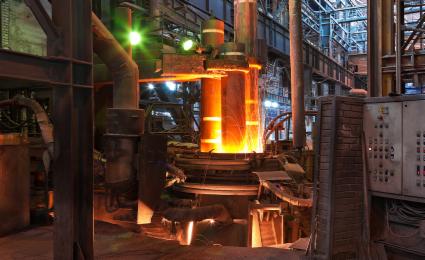Since January 2020, prices across all major commodity classes have risen significantly, posing a serious challenge to commodity processing firms. Aluminum prices, for instance, had almost doubled by early 2022. It’s a similar story for other industrial metals as well as for energy, chemicals, agricultural products and ocean shipping rates.


Boosting AI in steelmaking
A simple approach to overcome barriers and improve implementation of AI solutions
AI has the potential to transform the steelmaking industry. But adoption of the technology in the sector remains low. In this report, we look at the factors holding back implementation, and how steelmakers can give themselves an AI boost.

The steelmaking industry has invested heavily in established digital solutions in recent years to address its major challenges. Tools such as robots, predictive maintenance and image recognition are now common across key value chain steps, particularly in production and R&D.
"AI has a myriad of highly beneficial use cases across the steelmaking value chain and companies can readily exploit these if they focus on our AI boost priorities."
Yet the industry still compares poorly with other industries in terms of level of digitalization, especially when compared to the automotive industry. If steelmakers are to remain competitive, they need to urgently catch up.
Artificial intelligence (AI) and Generative AI solutions have the potential to transform steelmaking. In particular, generative AI (GenAI) promises to maximize outputs, improve operational efficiency and safety, while increasing competitiveness. In our report “AI in the steelmaking industry”, we assess the technology’s potential in the sector, drawing heavily on an exclusive industry survey. It focuses on the challenges, use cases, required capabilities and strategy changes, and outlines a five-step plan to boost AI adoption.
What steelmakers think of AI
According to our survey, steelmaking players think that (Gen)AI is best used in strategic support, to maximize the use of available data for scenario simulations, forecasts and decision-making processes.
But (Gen)AI can also strongly support steelmakers’ priorities across the value chain. Respondents scored production highest in terms of AI’s potential contribution (4.8 out of 5.0), particularly in relation to product quality and plant utilization and safety. AI’s potential to address supply-chain management priorities also scored highly (4.3), especially regarding optimizing input costs.
While some areas score better than others, AI use cases exist across the value chain. Used in combination, they will have a massive impact on competitiveness, from performance improvement and safety to innovation and sustainability. The report estimates a 10-15% overall cost advantage.
Despite this, the implementation of (Gen)AI in steelmaking is still at an early stage, rated at just 1.8 out of five by our survey respondents. Solutions lack maturity, and there is significant variation in the level of roll-out depending on company size and region. For example, 70% of survey respondents said that large companies are investing more and faster in AI.
What steelmakers need to do
So what can be done to address the situation? The report looks in detail at the factors that are holding back AI adoption in steelmaking. It finds that a lack of clear use cases is a major challenge, along with limited internal digital capabilities and enabling software/hardware. To overcome these challenges, our five-step plan focuses on the key priorities to boost AI adoption and exploit the unlimited opportunities the technology offers. For more details, download the full report.
Register now to access the full study, to learn more about a simple approach to overcome obstacles and enhance the implementation of AI solutions.









